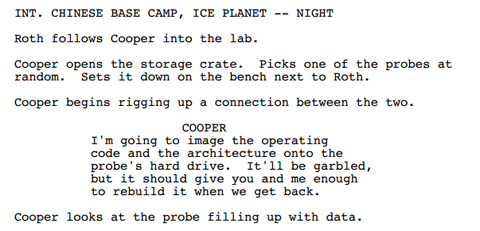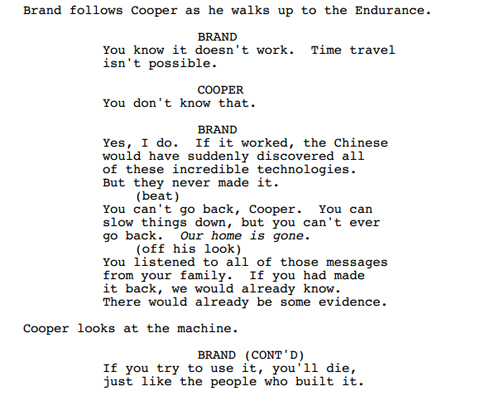
I am always interested in charting a game's development path and looking at what could have been. Games are subject to a lot of iterations and sometimes go through an entire redesign (as was the case for Splinter Cell: Conviction). That's why I would like to talk about Interstellar (which is not a game, bear with me) and how I was disappointed with what was eventually realised from the original script penned by Jonathan Nolan. You can read it in its entirety here and I'll be comparing it to the finished product in this post. For the sake of convenience, Jonathan Nolan's first version will henceforth be referred to as the script and the movie will be referred to as (wait for it) the movie. Also, spoilers.
Background
Jonathan Nolan wrote his script for Interstellar in 2007 based on a treatment put together by film producer Lynda Obst and theoretical physicist Kip Thorne. Steven Spielberg was initially attached to direct, but Christopher Nolan took over in 2012 and merged his brother's script with an idea of his own. The first half hour of both the script and the movie still play out largely the same. In the near future, Earth is no longer capable of sustaining humanity. Crops are destroyed by a series of blights and the lands are routinely scoured by recurrent dust storms. Matthew McConaughey plays Cooper, a former engineer who is disillusioned by humanity's apparent resignation at its fate through a focus on a failing agrarian society.
Then he discovers a secret NASA site where a group of scientists and astronauts are planning to use a wormhole recently discovered near Saturn to look for a new planet to colonise. Cooper is invited to join the mission and leaves his two children behind so he can save not just them, but all of humanity. From here on out, the script and the movie fork significantly, so let's take a look at how the two compare.
Fractal lifeform
What Cooper's team finds at the other end of the wormhole already differs substantially. In the movie, they find three planets that have been deemed possible candidates for sustaining human life, each having been visited by earlier missions through the wormhole. The script instead features a single ice planet caught between a neutron star and a black hole known as Pantagruel. Cooper's team quickly finds that this planet is doomed.

They also find an alien lifeform that takes the form of sentient plant life and provides a breathable atmosphere.

This lifeform plays a major role in the script and the way its life cycle and behaviour are described would have certainly put the special effects people through their paces. The movie drops it completely and Cooper's team instead finds something else...
Villain
Interstellar employs a bit of stunt casting with Matt Damon as an American astronaut stranded on one of the three candidate planets. His character has gone insane from years of isolation and he's obsessed with making it back to Earth. The script has an entirely different villain. It turns out the Chinese had launched a similar mission earlier and Cooper's team comes across the remnants of their expedition on the ice planet. One of the things they discover is a device made by the Chinese that can dial gravity up or down, which would conceivably allow the rest of humanity to flee Earth.

This crucial discovery is then jeopardised when the robots that were part of the Chinese mission make an appearance. They are still following procedures to keep the mission classified, which is why they try to prevent Cooper's team from making off with the device.

Eventually, they succeed in uploading the design specs of the device to a probe.

The idea of humanity escaping Earth by lowering its gravitational pull is kept in the movie, but it's introduced much earlier as an equation that Michael Caine's character is trying to solve. It takes Cooper entering a black hole to figure out how to make the equation work and he manages to send it into the past. That brings us to...
Stable time loop
Interstellar deals with the possibility of time travel through wormholes and the script creates a stable time loop with a probe that falls from the sky in the opening pages. Cooper can't decipher the data on it, but does manage to trace it back to the NASA site.

The origin of the probe is revealed towards the end of the script when Cooper's team ends up on a Chinese space station built by the robots.

There, Cooper wants to use a wormhole to get back to Earth, but then realises that the probe with the design for the gravity device is the only thing that will make it back.

He succeeds in sending the probe back, which then creates the stable time loop and saves humanity when Cooper's children and grandchildren decipher the data long after they've assumed he perished.
The movie is having none of this. In the climax, Cooper drops himself into a black hole and is there rescued by transcendental beings that transport him to what he describes as a tesseract. It's a visual representation of time as a space he can navigate. Inside the tesseract, Cooper is able to observe the past from a vantage point behind his daughter's bookcase. He manages to communicate with her by manipulating the books, a phenomenon she had attributed to some kind of ghost. In doing so, he sends himself the coordinates to the NASA site and creates a stable time loop. He also sends his daughter the final part of the equation that would allow Earth's gravity to be lowered.
This setup ties the loop to the bond between Cooper and his daughter in an overly sentimental fashion. The script only has four pages that deal with Cooper's descendants and their discovery of the gravity device. I suspect Christopher Nolan wanted to expand the scenes set on Earth and focus more on Cooper's daughter. But his most ludicrous addition to the script is...
Love is the fifth dimension
In the movie, Anne Hathaway's character theorises that love is a force that can transcend time and space. She describes it as if it were an observable phenomenon like gravity and it ultimately underpins Cooper's use of the tesseract to save humanity. It's a ridiculous notion that reminded me a lot of The Fifth Element, a wonderfully campy movie in which love is the titular fifth element that saves the world.
The script's third act could do with a lot of streamlining and relies too much on character exposition to bring across a miriad of new concepts in a short timeframe, but the probe provides a more practical incentive and just makes more sense than "love did it."
While Christopher Nolan is a demonstrably talented director, his big-budget movies have often been criticised for their cold and artificial approach in cultivating emotional scenes. It seems he wanted to do better with Interstellar and goes overboard by working a maudlin idea of love into the epicentre of the movie's scientific premise.
For that reason above all, I prefer the script over the eventual movie. That being said, the script does feature a sex scene in zero gravity and I'm glad they decided to cut that. A lot of movies tried to work in zero-g fight scenes after Inception and Interstellar steered clear of setting a similar precedent.

Okay, I'll get back to writing wacky game scripts now.
Comments
Add new comment